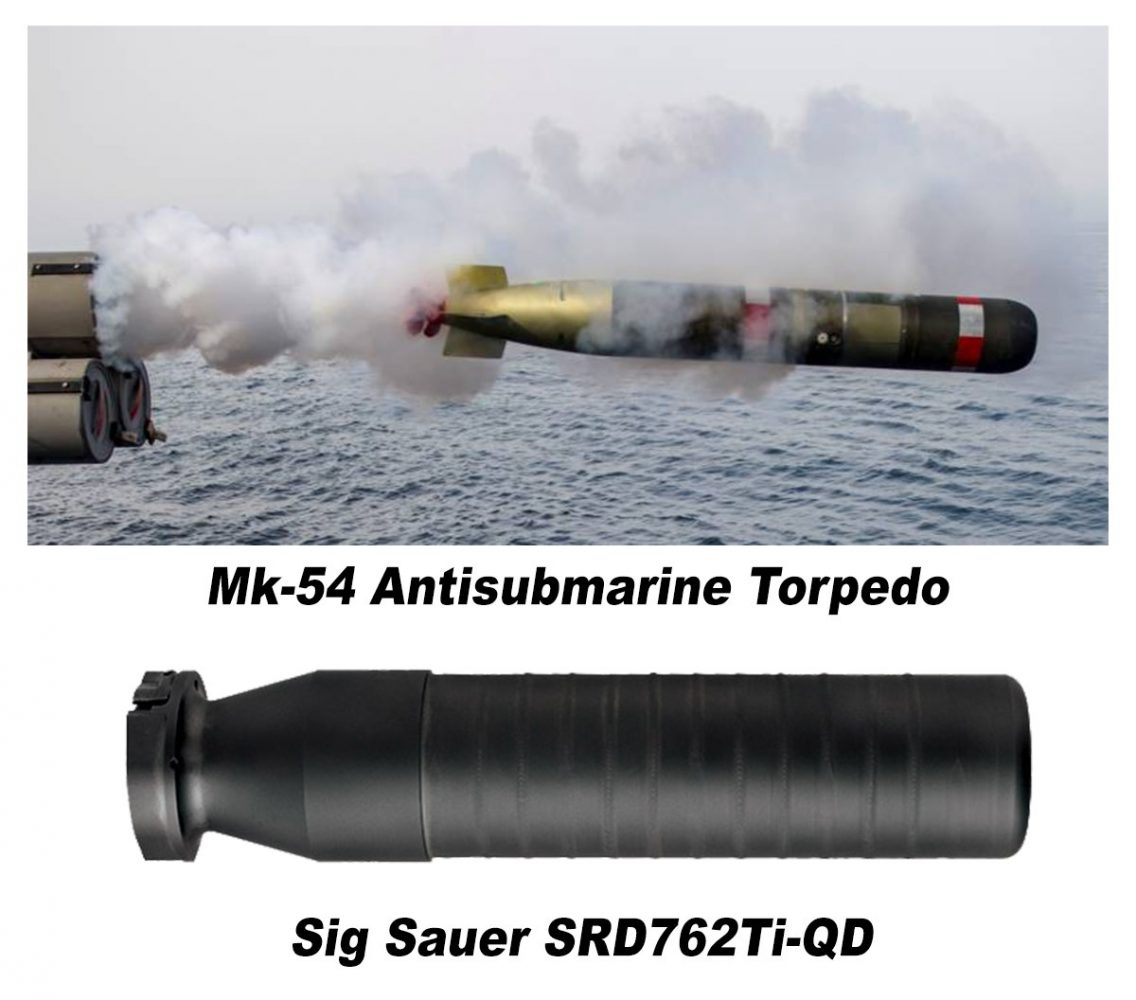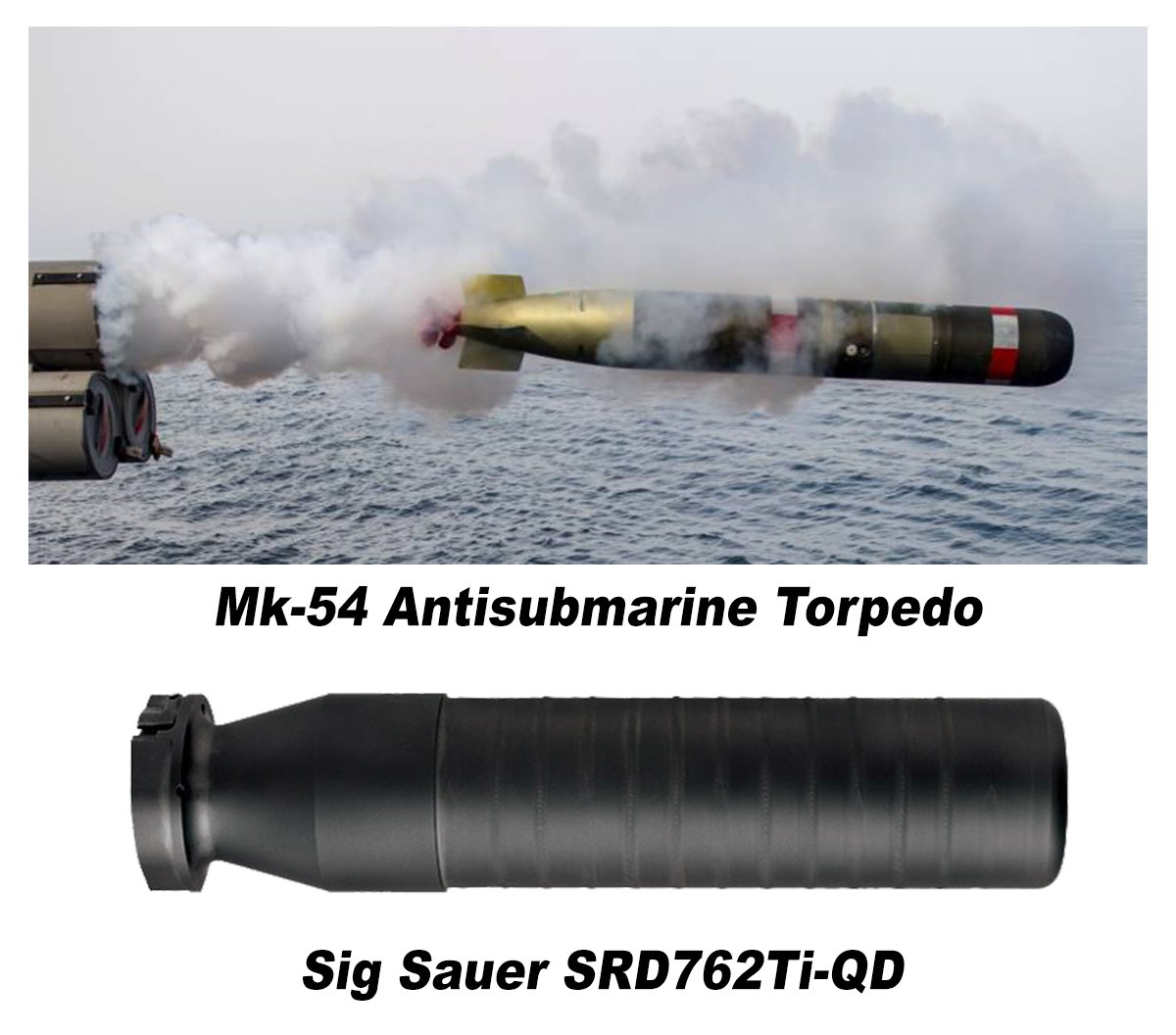
Coincidence? Hmmm….
When I first saw the new crop of Sig Sauer rifle suppressors with their iconic shape, I knew that look was familiar. Then it hit me. It’s almost a dead ringer for the US Navy’s Mk-54 Antisubmarine Torpedo. Coincidence? I think not…
There are a couple of differences. Don’t run this suppressor “wet” like the Mk-54. Rifle-sized pressures and operating “wet” don’t usually go together, at least not safely. Another difference is that the Sig Sauer SRD762Ti-QD is noticeably lighter than the Mk-54, probably because of the use of Titanium. That and the much smaller size. Last, but not least, the Sig SRD762 is way quieter when it goes off. Oh, and as far as I know, the Sig SRD762Ti-QD doesn’t have a magnetic detonator either.
Thanks to some help from our friends at Silencer Shop, I got my hands on a brand-spankin’ new SIG Sauer SRD762Ti-QD suppressor for some serious fun (work and highly scientific testing.) As the name implies, this is a .308 / 7.62mm suppressor, but it’s rated for up to 300 Win Mag and any other cartridge that has same or smaller diameter and pressure.
Sig offers two different designs of the SRD762 suppressor and two different mounting systems, so in total there are four different models in the SRD762 family.
There is a standard SRD762 and an SRD762Ti. The standard model is made from Inconel 718, a Nickel Alloy Stainless Steel. The “Ti” model uses Titanium as the name implies. Basically, you’ll want to choose the Iconel version for heavy and abusive use. The Titanium model uses lighter material so it can be a bit bigger without making the suppressor heavier. Bigger means more air inside, which means less pressure and less noise. Make no mistake, the Titanium version is plenty durable, but if you’re going to use it in a sandbox, maybe choose the Iconel model.
Both models are available in fixed thread mount or QD (quick detach) mount configurations. The new QD system is pretty darn clever, and we’ll get into that more in a minute. The fixed thread models of the SRD762 models use ⅝-inch x 24tpi threading.
Due to the different combinations of materials and mounting systems, the four models have different dimensions and sound suppression performance. Here’s a quick summary.
Tubeless
Most suppressors have a series of baffles that are assembled and then placed inside of an exterior sleeve or tube that contains everything and holds the system together. Many rifle suppressors are permanently constructed this way to handle the crazy high pressures of rifle cartridges. The result is that part of the assembly, and associated weight, serves no real purpose other than structural support. Additionally, the space used by the support tube means less sound-suppressing interior volume inside for any given exterior size. From a pure noise-reduction perspective, the bigger you can make the interior volume, the better.

The QD package mount system is actually two pieces – the suppressor mount itself and a muzzle brake insert.
The idea is that by constructing the entire silencer completely from the baffles, there is more space for air inside and less weight allocated to structural support only. This is why you’ll see a series of ridges all along the suppressor exterior. Those are the weld joints where the baffle rings are attached to each other. It’s a clever idea. Plus, it looks kind of cool. The weld joints are perfectly uniform, so they don’t look like weld joints. They look more like some form of decorative texturing pattern.
The blast chamber at the base is made from one solid hunk of metal and the baffle rings extend from there forward.
Mounting System
The mounting system on this suppressor is, well, brilliant. Here’s why.
Direct-thread mount systems are easy and stable. You just screw it onto a threaded barrel and start shooting. The downsides are that it doesn’t come on and off easily and your point of impact may vary between on and off episodes as the silencer mounts a little differently each time. Of course, if you leave a suppressor on one rifle forever, this is a moot point, assuming you don’t remove it for cleaning or maintenance.









Inconel is NOT a stainless steel alloy, it has very little iron in it, it is simply a nickel based alloy.